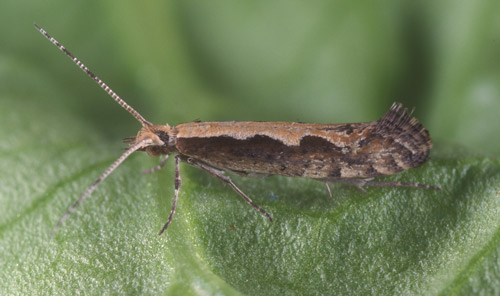By Clint Thompson
Brassica growers rely almost entirely on insecticides to manage diamondback moth (DBM) infestations. However, the moths have shown the ability to develop resistance to a broad range of insecticides, says Hugh Smith, an associate professor of entomology and nematology at the University of Florida Institute of Food and Agricultural Sciences (UF/IFAS) Gulf Coast Research and Education Center.

Credit: Lyle Buss, UF/IFAS
“One component of managing DBM is monitoring insecticide susceptibility, which involves collecting larvae from farms and testing them in the lab. This provides some information on which insecticides are working and which are not. It has been consistently observed in Florida and elsewhere that pyrethroid insecticides and Lannate (methomyl) do not work well on DBM populations,” Smith said.
He added that diamide insecticides chlorantraniliprole (Coragen) and cyantraniliprole (Verimark/Exirel) are used extensively for management. However, resistance monitoring programs in Florida and Georgia reveal tolerance to these materials in field populations. Field populations of DBM in Florida have consistently shown susceptibility to emamectin benzoate (Proclaim), spinetoram (Radiant SC) and XenTari (Bt strain aizawi). Tolfenpyrad (Torac), indoxacarb (Avaunt) and naled (Dibrom) have also demonstrated efficacy.
“Growers rely almost exclusively on insecticides to manage DBM, but DBM has consistently demonstrated the ability to develop resistance to a broad range of insecticides, which is the main reason it is a global pest,” Smith said. “Because primary reliance on insecticides is clearly not a solution to managing DBM, research is being carried out across the United States and in other countries on developing alternative methods of management. These include the use of pheromone-based mating disruption to reduce egg-laying by females and evaluation of biologically-based insecticides which should not produce resistant DBM populations.”
Smith noted that there are multiple predators and parasitic wasps on Florida brassica farms that can help reduce DBM numbers.
Female moths will lay eggs on plants, usually on the new growth. Larvae (caterpillars) hatch from the eggs and begin feeding. Initial feeding from young larvae produces a windowpane type of damage where the surface tissue is removed. Older larvae produce holes in leaves and make the plant unmarketable.
To learn more about this research and all of the other exciting things going on at the University of Florida’s Gulf Coast Research and Education Center, join us on Nov. 2 for the Florida Ag Expo. Register now!

